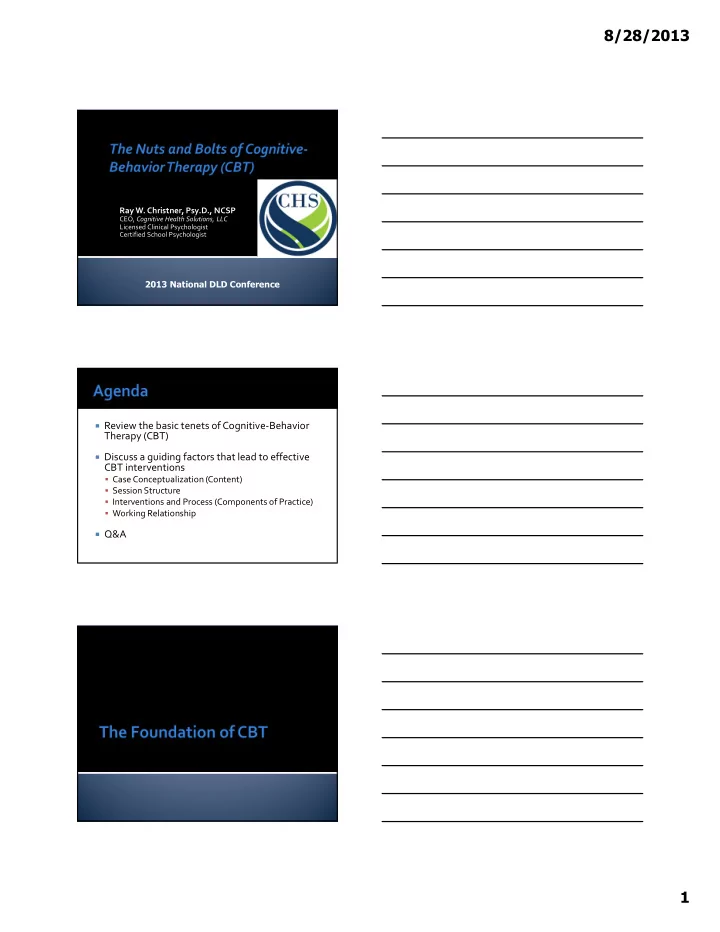

��������� Ray W. Christner, Psy.D., NCSP CEO, Cognitive Health Solutions, LLC Licensed Clinical Psychologist Certified School Psychologist ���������������������������� � Review the basic tenets of Cognitive-Behavior Therapy (CBT) � Discuss a guiding factors that lead to effective CBT interventions � Case Conceptualization (Content) � Session Structure � Interventions and Process (Components of Practice) � Working Relationship � Q&A �
��������� � Automatic Thoughts – thoughts that occur without much consideration (habitual and reflexive) � Core Beliefs – fundamental beliefs that influence response to a situation (e.g., how we think, feel, and act) � Schema – a cognitive framework that serves as a basis for screening, organizing, and interpreting situations based on past experiences (e.g., clusters of core beliefs about the self, others, and the future) ����������� ��������� ���������� ���������� ������� ����� �������� �������� Situational Problem Behavioral Cognitive Affective/ Physiological ������������������������������������ �
��������� � Cognitive Deficiency – the lack of information processing � Cognitive Distortions – an active but misguided way of processing information � Skill Deficiency – the lack of a specific skill � Skill Dysfunction – the lack of implementation or generalization of skill Socializing Children to Therapy �
��������� ������� �������� ��������� ��������� �
��������� ������������ ������ "�������� ���������������������� CHANGE ���������� !������ ��� ������� !�������� ������������������������������������ ���������������������� � Conceptualize the problem � Select problem of focus/intervention point � Determine goals � Choose interventions and techniques � Helps predict behavior � Manage noncompliance �
��������� � Identifying Data/Personal Information � Problem List � Relevant Assessment Data � Antecedents and Triggers � Developmental considerations � Cultural consideration � Protective/Resiliency Factors � Risk Factors � Readiness to Change � Impediments to Change � Working Hypothesis � Origins of Working Hypothesis Progress Monitoring $ Assessment � Conceptualization " Treatment Planning ������������������������������������ ���������������������� ���������� ��� ������� #
��������� � Manual-Based Interventions � Modular-Based Interventions � Benefits � Specific content to be addressed � Clearly defined procedures to use � Step-by-step procedures to follow � Articulated activities to follow � Outcome research � Difficulties � Not meeting the individual needs of clients � Difficulty getting clients to attend 15 to 20 sessions � Addressing the clients’ skills but not the barriers and difficulties that affect implementation � Anxiety � Coping Cat (Kendall, 1993) � Social Effectiveness Therapy for Children (Beidel & Turner, 1998) � Child Anxiety Management Program (CAMP; Friedberg & Elamir, in preparation) � Cognitive-Behavior Group Therapy - Adolescent (CBGT-A; Albano, 2000) � Coping Koala (Barrett, 1995) � Anger and Aggression � Chill Out Program (Feindler & Ecton, 1986; Feindler & Gutman, 1996) � Coping Power Program (Larson & Lochman, 2002) � “Keeping Cool” (Dwivedi & Gupta, 2000). � Aggression Replacement Training (ART; Goldstein, Glick, & Gibbs, 1998) %
��������� � Depression � Coping with Depression (Clarke, Lewinsohn, & Hops, 1990; 2003) � ACTION Program (Stark & Kendall, 1996) � Social Problem Solving � I Can Problem Solve (Shure, 1994) � Social Problem Solving (SPS; Elias & Tobias, 1996) � Benefits � Decreases the demands of following a manual-based program � Uses specific techniques from manual-based programs � Allows the use of outcome research to develop good interventions � Bases intervention on specific client needs � Difficulties � Must have good case conceptualization skills � Must use single case design and progress monitoring more efficiently to measure outcome � Must have a good understanding of the literature across various disorders � Benefits � Decreases the demands of following a manual-based program � Uses specific techniques from manual-based programs � Allows the use of outcome research to develop good interventions � Bases intervention on specific client needs � Difficulties � Must have good case conceptualization skills � Must use single case design and progress monitoring more efficiently to measure outcome � Must have a good understanding of the literature across various disorders �
��������� � Goal Setting � Cognitive Restructuring/Reattribution � Exposure/Response Prevention � Relaxation � Modeling � Psychoeducation � Self-Monitoring � Self-Praise/Positive Self-Talk � Problem Solving � Assertiveness Skills � Social Skills � Communication Skills � Activity Scheduling � Behavioral Contracting � Relapse Prevention/Maintenance � Guided Imagery � Relationship Building � Personal Safety Skills '��(������)���������������������������* ���������������������� ���������� !������ ��� ������� !�������� &
��������� � Relational check in � Set agenda for this session � Solicit feedback regarding previous session � Review current status and events since last session � Review homework from previous session � Focus on main agenda items (e.g., skill building) � Develop new homework assignment � Solicit feedback regarding current session ������������������������������������ ������������ ������ "�������� ���������������������� CHANGE ���������� !������ ��� ������� !�������� ������������������������������������ � Away from the model of “separate self” � Towards a model of connection where we grow in, through, and toward relationship � Good connection with others is central to psychological well being ��
��������� � Disconnection is inevitable and part of being in relationship � They are often caused by empathic failure � Strengthened relationships result when the injured is able to represent his/her feelings and the other responds empathetically � When he/she receives a response of indifference additional injury or denial of her experience occurs and leads to failures in growth fostering relationship thus less zest-empowerment-clarity-worth- and desire for connection � Make the creation and cultivation of a therapy relationship a primary aim. Be up-front Give and gain respect Develop goals together Agree on tasks of treatment Establish and maintain interpersonal bond Provide safety to see and be seen, know and be known � Routinely monitor child’s responses to the therapy relationship and ongoing treatment. ������������ ������ "�������� ���������������������� CHANGE CHANGE ���������� !������ ��� ������� !�������� ������������������������������������ ��
��������� (((+��,����)�-�����!��������+��� ��
Recommend
More recommend